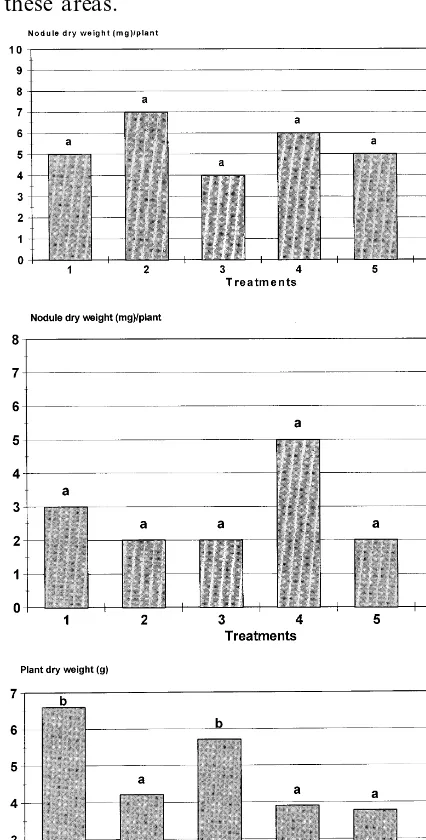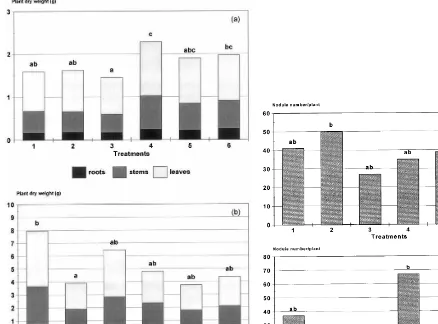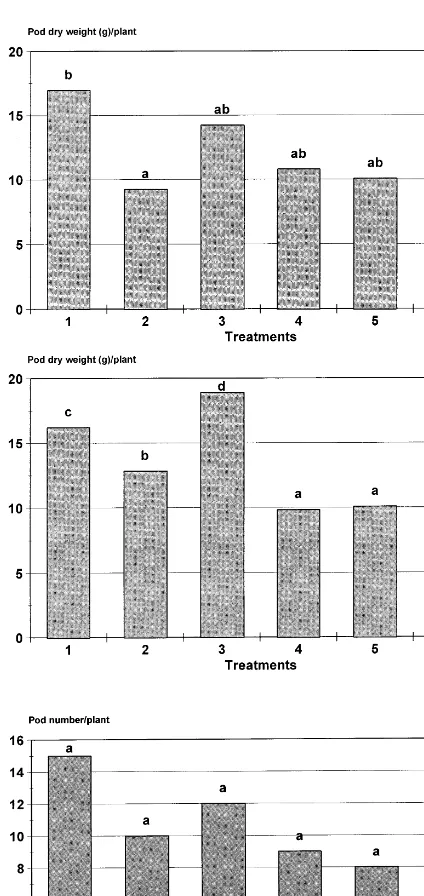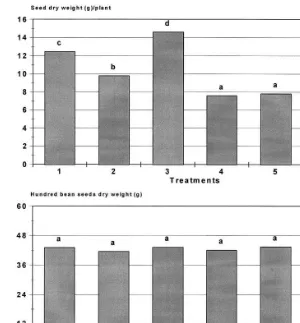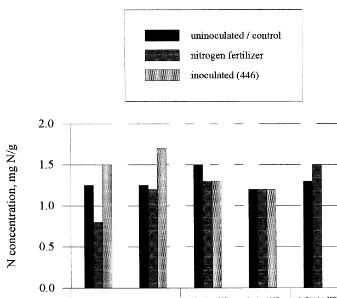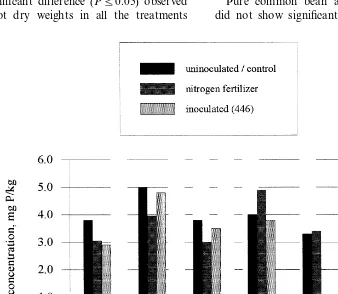European Journal of Agronomy 14 (2001) 1 – 12
Nitrogen fixation by common bean (
Phaseolus
6
ulgaris
L.)
in pure and mixed stands in semi-arid south-east Kenya
John M. Maingi
a, Chris A. Shisanya
b,*, Nkanata M. Gitonga
a,
Berthold Hornetz
caDepartment of Botany,Kenyatta Uni6ersity,PO Box43844,Nairobi,Kenya bDepartment of Geography,Kenyatta Uni6ersity,PO Box43844,Nairobi,Kenya
cFB VI/Geogr.-Geosciences,Uni6ersity of Trier,D-54286Trier,Germany Received 5 October 1999; accepted 13 April 2000
Abstract
Research was carried out in the field on the effect of intercropping common bean and maize crops in a semi-arid zone of south-east Kenya over two rainy seasons in 1997. The experimental design was a randomised complete block design with eight treatments replicated four times. Significant differences were observed in total plant dry weight by the different treatments in pure stands, 21 days after emergence with higher values under mixed cropping system in common beans. However, at 42 days after emergence, plant dry weights in uninoculated common bean pure stands with N application were significantly higher than under other treatments. Common bean yields were significantly reduced by the maize intercrop. The inoculated common bean and N application treatment recorded the largest seed dry weights and subsequently yields per hectare. These findings suggest that intercropping common beans and maize considerably suppresses the yield of the former under the semi-arid conditions of south-east Kenya. Inoculation of common bean with the commercially availableRhizobium strain 446 on the other hand was effective and improved yields. Soil analysis of the experimental plots before and after one cropping season indicated that common beans increased N slightly or maintained it at the pre-planting levels. This was unlike the pure maize plots where there was a marked decline in soil N. There was however, a marked increase in soil phosphorus in all treatment plots. © 2001 Elsevier Science B.V. All rights reserved.
Keywords:Common bean; Crop yield; Inoculation; Intercropping; Nodulation
www.elsevier.com/locate/eja
1. Introduction
In Kenya, the most commonly grown legumes are field beans (Phaseolus6ulgarisL.), Pigeon peas
(Cajanus cajan L.) and field peas (Pisum sati6um
L.; Shisanya, 1998). Among these, field beans are the most widely cultivated. The crop is grown in all agricultural areas of Kenya except the low-lands (Acland, 1971; Hornetz, 1997). Currently, production of common beans and other food crops in the marginal areas of Kenya has lagged
* Corresponding author. Tel./fax: +254-2-606809. E-mail address:[email protected] (C.A. Shisanya).
behind population growth (Shisanya, 1996; Hor-netz, 1997). There is an urgent need to increase food production for the expanding population in these areas.
Research work has shown that total grain and plant-nitrogen (N) yields can be significantly in-creased by intercropping legumes with non-legumes (Barker and Blamey, 1985). Most farmers in developing countries have adapted this low-in-put system mainly for climatic and socio-eco-nomic reasons (Okigbo and Greenland, 1976; Kang, 1988). Mixed cropping of cereals and legumes is widespread in the tropics (Ofori and Stern, 1987) because legumes used in crop produc-tion have tradiproduc-tionally enabled farmers to cope with erosion and with declining levels of soil organic matter and available N (Scott et al., 1987). Biological nitrogen fixation (BNF), which enables legumes to use atmospheric N2 is
impor-tant in legume-based cropping systems where N is limited. Evidence suggests that associated cereals may benefit through N transfer from legumes (Fujita et al., 1990). Land productivity measured by land equivalent ratio and monetary gain showed some advantages of mixed cropping of cereals and legumes (Yunusa, 1989; Mandal et al., 1990).
Intercropping has gained interest in research because of the two potential advantages it offers: overyielding, i.e. improved utilisation of growth resources by the crop, and improved reliability from season to season (Helenius, 1990; Helenius and Jokinen, 1994). If a legume is grown in association with another crop, commonly a cereal, the N nutrition of the associated crop may be improved by direct N transfer from the legume to the cereal (Giller and Wilson, 1991). The legume uses fixed atmospheric N2 rather than the soil
mineral N which can be exploited by the compan-ion crop (Vallis, 1967). Therefore, productivity normally is potentially enhanced by the inclusion of a legume in the cropping system. However, under rainfed conditions of the semi-arid areas like south-east Kenya, C4 cereal plants like sor-ghum and maize seem to be more successful in terms of adequate water supply compared to the associated legumes, particularly drought adapted crop varieties under water stress conditions (Hor-netz, 1997).
There is very little research that has been car-ried out on the effectiveness of N2 fixation of Fig. 1. Effect of N source and cropping system on per plant
J.M.Maingi et al./Europ.J.Agronomy14 (2001) 1 – 12 3
Fig. 2. Effect of N source and cropping system on nodules of beans (a) nodule dry weights 21 DAE; (b) nodule dry weights at 42 DAE; (c) nodule number 21 DAE; (d) nodule number at 42 DAE. Bars followed by the same letter are not significantly different by Duncan’s multiple range test atP50.05. Treatments: (1) ininoculated beans and N-fertillizer; (2) uninoculated beans and no N-fertiliser; (3) inoculated beans and no N-fertiliser; (4) bean-maize intercrop and fertilizer and no inoculation; (5) maize-bean intercrop uninoculated and no N-fertiliser; (6) maize bean intercrop inoculated and no N-fertiliser.
indigenous (natural) and inoculated (host-spe-cific) rhizobia strains and intercropping in the semi-arid areas of south-east Kenya (Gitonga et al., 1999). Pilbeam et al. (1995) found significant N increase in the plant tissues of drought adapted cowpea (Vigna unguiculata L. Walp) in the study area. In the same study, N fertiliser addition had no significant effect on the dry matter yield and N content of maize (Zea mays
L. cv. Makueni DLC). An important limiting factor existing in the semi-arid areas of south-east Kenya is the fact that the prevalent soils,
i.e. Fluvisols, Luvisols and Ferralsols (Eichinger, 1999) release important plant nutrients only af-ter short periods of cultivation (Hornetz, 1997).
No research attention has been given to N2
fixation of the local varieties of legumes used by the farmers and the effect of intercropping these legumes with local maize variety Kinyanya in semi-arid south-east Kenya. The major objective of this study was therefore to investigate the effect of intercropping on nitrogen fixation
un-der a semi-arid environment of south-east
Fig. 3. Effect of N source and cropping system on pods of common beans (a) pod dry weight/plant at 42 DAE; (b) pod dry weight/plant at 70 DAE; (c) pod number/plant 42 DAE. Bars followed by the same letter are not significantly different by Duncan’s multiple range test atP50.05. Treatments: (1) ininoculated beans and N-fertillizer; (2) uninoculated beans and no N-fertiliser; (3) inoculated beans and no N-fertiliser; (4) bean-maize intercrop and fertilizer and no inoculation; (5) maize-bean intercrop uninoculated and no N-fertiliser; (6) maize bean intercrop inoculated and no N-fertiliser.
2. Materials and methods
2.1. Experimental site
The experiments were carried out at Kenya Agricultural Research Institute (KARI), Kiboko sub-centre (latitude 02° 12%S, longitude 37° 43%E,
altitude 975 m a.s.l.), located at about 160 km south east of Nairobi, the capital town of Kenya. The soils of the study area are well-drained Fluvi-sols, Ferralsols and Luvisols. The soil pH is 6.9 (measured in 0.01 ml−1
CaCl2). Analysis of soil N
and P by the method described by Forster (1995a,b), indicates a deficiency on both (0.7 mg N/g soil and 3.0 mg P/kg soil in 0 – 60 cm soil depth, respectively). These values of soil N and P are below the threshold values of 2.0 mg N/g soil and 4.5 mg P/kg soil for optimum crop growth in tropical soils, respectively) (Kapkiyai et al., 1999). The C/N ratio and CEC are 11.7 and 7.8 mmol/ kg, respectively (Eichinger, 1999). These values are classified as high (Landon, 1991) and low (FAO, 1977), respectively. Rainfall is bimodally distributed, with median monthly maximum in April (126 mm) and November (138 mm). The median annual rainfall is about 582 mm/year. The short rains (October – January) generally have more rainfall and are more reliable than the long rains (March – June; Musembi and Griffiths, 1986). Mean monthly temperatures are highest in February (24.3°C) and October (23.4°C), prior to the onset of the rains in March and November, respectively (KMD, 1984).
2.2. Seeds and rhizobium culture
Seeds of local maize and common beans were obtained from local farmers. The seeds were care-fully selected to ensure uniformity in size and colour. Commercial Rhizobium leguminosarum
biovar. phaseoli strain 446 used to inoculate the common bean was obtained from the Microbio-logical Resource Centre (MIRCEN), University of Nairobi.
2.2.1. Field experiments
J.M.Maingi et al./Europ.J.Agronomy14 (2001) 1 – 12 5
Fig. 4. Effect of N source and cropping system on dry seed weight of common beans (a) total sed dry weight; (b) 100 seed dry weight. Bars followed by the same letter are not significantly different by Duncan’s multiple range test atP50.05. Treatments: (1) ininoculated beans and N-fertillizer; (2) uninoculated beans and no N-fertiliser; (3) inoculated beans and no N-fertiliser; (4) bean-maize intercrop and fertilizer and no inoculation; (5) maize-bean intercrop uninoculated and no N-fertiliser; (6) maize bean intercrop inoculated and no N-fertiliser.
two seasons. Thus the results presented in this paper are the pooled data from the two seasons. Average seasonal rainfall amount during the ex-perimental period was 336 mm. Soil moisture was monitored in the experimental plots daily using calibrated gypsum electrodes (SOILMOISTURE Sta. Barbara, California, USA), for the entire growing period.
The field experiments were made up of eight treatments as follows:
1. common bean in pure stands with N-fertiliser and no inoculation;
2. common bean in pure stands with no N-fer-tiliser and no inoculation (control);
3. common bean in pure stands inoculated
with Rhizobium strain 446 and no
N-fertiliser;
4. common bean – maize intercrop with N-fer-tiliser added and no inoculation;
5. common bean – maize intercrop with no N-fer-tiliser and no inoculation;
6. common bean – maize intercrop inoculated
with Rhizobiumstrain 446 and no N-fertiliser;
7. maize pure stand with N; and 8. maize pure stand with no N.
At planting time all seeds were dressed with Furadan chemical (active ingredient 5% carbo-furan) at a rate of 5 g/kg of seed to control soil pests like cut-worms (Agrotis ipsilon). Maize was sown in rows of 75 cm apart with a spacing of 30 cm between plants in the row yielding a plant density of 44 400 plants/ha. Common beans were sown 50 cm between rows and 20 cm within rows, giving a density of 100 000 plants/ha. The inter-crop plots consisted of alternating maize/bean rows with planting densities same as those in the respective pure crops. These are the recommended plant densities for the semi-arid south-east Kenya (Shisanya, 1996).
Land preparation was carried out by tractor ploughing followed by harrowing. A basal dose of
triple superphosphate granules (TSP; 50% P2O5)
fertiliser was applied at the rate of 40 kg/ha to all
the plots, to minimise plant phosphorus
deficiencies.
Before planting, common beans for inoculation treatments were rinsed in 10% sucrose solution to help the inoculant carrier material (filtermud) to stick on the seeds (Kibunja, 1984). Inoculation with rhizobia was carried out by addition of 6.7 g of filtermud based inoculant for every kg of moistened sucrose-coated common beans. This was followed by thorough mixing of the seeds with the inoculant until the seeds were uniformly coated. The inoculated seeds were kept covered in a container to avoid exposure to direct sunlight.
The crops were dry planted before the onset of the rains in each season. This is a common prac-tice in the study area (Shisanya, 1996). For each of the crops, four seeds were planted per hole. One week after seed emergence, the first weeding took place and the plants were thinned to two per hole. At 10 days after emergence (DAE), the plants for N-fertiliser treatment were top-dressed with calcium ammonium nitrate fertiliser (CAN, 26% N) at the rate of 40 kg/ha. The second weeding was carried out 21 DAE when the plants were about 20 cm above ground.
Plants were sampled 21days and 42 days after emergence (DAE) and at full physiological matu-rity (70 DAE). Two plants were randomly
sam-pled from each plot and various growth
parameters determined. The plant material was partitioned into roots, stems and leaves. The plants were dug up for nodule counting (in case of common beans) and determination of below ground biomass. Plant samples and nodules were oven dried at 70°C to constant weight. Dry weights of the various parts of the plant samples were determined and recorded using a high preci-sion Sartorius balance. From the final harvest, the following data were collected: pod number and pod dry weight of common bean, dry weight of pods per plant, cob dry weight per plant in maize, seed (grain) dry weight per plot, 100 seed dry weight and the yield per treatment plot.
Nitrogen and carbon contents from final sam-pling were analysed using the high sensitivity ni-trogen – carbon analyser (Sumigraph NC-90). Soil
Table 1
Effects of intercropping on the yield of common beans and maize grown at Kiboko, Kenya, over two cropping seasons of 1997a
Common beans
Treatment Maize yield
yield (kg/ha) (kg/ha)
– (1) Common beans 1244c
uninoculated+N*
(2) Common beans 979d – uninoculated
(control) B-UNC
1459b
(3) Common beans –
inoculated**
(4) Common beans 761e 3870c uninoculated
+maize+N
(5) Common beans 664f 3820c uninoculated
+maize
(6) Common beans 831de 3829c inoculated+maize
(7) Maize pure – 4277b
stand+N
–
(8) Maize pure stand 4120b with no N
aMeans followed by the same letter down the column are not significantly different (P50.05) by Duncan’s multiple range test.
* N fertilizer was topdressed 10 DAE at the rate of 40 kg/ha of CAN powder.
J.M.Maingi et al./Europ.J.Agronomy14 (2001) 1 – 12 7
Fig. 5. Soil nitrogen (N) concentration in cropping systems with common beans and maize at Kiboko (topsoil, long rains (l.r.) 1997).
samples were taken as composite samples (five samples per plot then mixed to give a composite sample) and nitrogen analysed before and after crop harvest using the Kjeldahl method (Bremner and Mulvaney, 1982). Soil phosphorus was deter-mined using the Olsen method (Watanabe and Olsen, 1965). Nodule number and weight were also determined.
Data obtained were analysed and presented using both descriptive and qualitative statistical procedures. Data were subjected to analysis of variance (ANOVA) and means separated using Duncan’s multiple range test at P50.05 (Steel and Torrie, 1981).
3. Results
There were no significant differences (P50.05) in total plant dry weights between the different
treatments in pure bean plants, 21 DAE (Fig. 1a) and also between the maize – common bean inter-crop. The total plant dry weight, however, was significantly higher in the inoculated common bean – maize intercrop plants than in the inocu-lated common bean pure plants. The effect of N-fertiliser treatment on total dry matter of inter-crop plants was significantly higher than in pure common bean plants. Generally, the total dry weights of the pure bean plants 21 DAE were lower than the dry weights of the intercrop com-mon bean plants.
differences (P50.05) in total plant dry weights between the control and inoculated plants. The total dry weights of the intercrop common beans by different treatments did not differ significantly, and were similar to the control.
In Fig. 1c, all the intercrop common bean plants at 70 DAE had significantly lower dry weights than the N-fertiliser pure common bean plants and the inoculated pure common bean plants, but did not differ significantly from the control (2). Shoot dry weights of the intercrop plants were higher than those of the pure plants, at 21 DAE. Different treatments had no effect on the shoot dry weights of the pure common bean plants, and only N-fertiliser treated intercrop common beans showed larger shoot dry weights than all the other treatments. At 42 DAE there was no significant difference (P50.05) observed in the shoot dry weights in all the treatments
except the N-fertiliser treatment. At 21 DAE none of the treatments affected significantly the root dry weights of pure common beans. In the inter-crop, the root dry weights were similar in all treatments. However, the root dry weights were higher in the common bean intercrop than the pure stands. At 42 DAE the root dry weights did not vary significantly (P50.05) for all treatments. Inoculation had no significant effect on the nodule number per plant at 21 DAE (Fig. 2c,d, respectively). Similar effect was observed at 42 DAE. Only treatments (2) and (4) were signifi-cantly different. There was no significant differ-ence (P50.05) in nodule dry weights by all treatments at 21 and 42 DAE (Fig. 2a,b, respec-tively). Inoculation had no significant effect on nodule dry weight.
Pure common bean and intercrop treatments did not show significant difference (P50.05) in
J.M.Maingi et al./Europ.J.Agronomy14 (2001) 1 – 12 9
pod numbers at 42 DAE (Fig. 3c). However, a significant difference (P50.05) was observed in
pods dry weights (Fig. 3a). The N-fertiliser (1) treatment gave larger pod dry weight/plant com-paring to the control. From Fig. 3b, pod dry weight/plant was significantly larger (P50.05) in (3) than (1). There was no significant difference (P50.05) in pod dry weight/plant of intercrop plants at final harvest.
Treatment (3) gave the largest seed dry weight/ plant followed by (1) (Fig. 4a), significantly differ-ent (P50.05) from (2). Significant differences (P50.05) were observed in total common bean seed yield/ha between the pure and intercrop treatments (Table 1). There were no significant differences (P50.05) in the 100-seed dry weights
for all.
The analysis of soil nitrogen before and after the cropping season showed that plots with com-mon beans as pure crop and intercrop had sta-bilised and partly enriched soil N during the vegetative periods (Fig. 5). Phosphorus content in the soil increased in all of the plots by between 5 and 66%, being lowest in plots with common beans – maize intercrop and highest in pure com-mon bean inoculated plants (Fig. 6).
4. Discussion
Most researchers are aware of the benefits of inoculating legume seeds with suitable strains of nodulating bacteria. A simple trial to determine the need for inoculation requires only three treat-ments (Vincent, 1974): (a) an uninoculated control to check for the presence or absence of native rhizobia and their effectiveness; (b) an inoculated treatment using Rhizobium effective for the present host; and (c) an uninoculated treatment plus N.
Plant dry weight was used indirectly to estimate N2 fixation in the present study. There were no
significant differences in the growth parameters measured in the early development of common beans. This implies that they were deriving their nutrients from the soil and seed and none had an advantage over the other. At final harvest, inocu-lated beans and N treated common beans had
significantly higher dry weights than the control. This is an indication that inoculation had a sig-nificant effect on N2 fixation and therefore the
indigenous rhizobia were not so efficient in fixa-tion (Wani et al., 1995). These results are contrary of those found by Pilbeam et al. (1995), who reported that both N-fertilisation and inoculation did not improve yield of common beans in the study area. Response to inoculation is expected: (a) in soils in which the specific rhizobia are absent or sparse; and (b) where indigenous rhizo-bia are ineffective or partially effective in N2
fixation (Vincent, 1974; Halliday, 1984; Gitonga et al., 1999). When a legume is inoculated success-fully, the resulting functional nodules quickly make the legume independent of soil N, the plant produces a protein-rich seed and the soil is left enriched in N (Ayanaba, 1977; Ayanaba and Bromheld, 1980).
There were no significant differences in most measured parameters at harvest, comparing to pure stands, except for higher values obtained for pure uninoculated beans without N application. This is an indication that intercropping sup-pressed the legume growth. Similar observations have been made by Ayisi and Poswell (1997), and Hornetz (1997) under adequate water supply. This could have been due to competition between the common beans and maize for limited N and phosphorus nutrients in the soil (Brockwell et al., 1995), sharing of fixed N2 with the maize and
shading which reduced photosynthesis (Tanaka and Fujita, 1979). The mineralisation rate under such climatic conditions has been found to be so fast within the short growth cycle period (Hor-netz, 1997; Eichinger, 1999). According to Ledgard et al. (1985), Danso et al. (1986, 1988), Hardarson et al. (1988) and Launauce (1996), among others, for temperate and cold climates, it seems that very little N is transferred in a short-term period, up to 6 months, because mineralisa-tion must take place. The effect of intercropping seems to overshadow treatment effects in common beans such that no significant differences were observed in the intercropped beans in various treatments. N2 fixation with common beans is
usually not well succeeded either because selected
indige-nousRhizobium, well adapted for the actual envi-ronmental conditions, by the high soil tempera-tures and by the low soil moisture.
Maize as a C4 plant is usually a more competi-tive crop at the expense of a legume in maize – bean intercropping systems (Crookston and Hill, 1979; Gitonga et al., 1999). Analysis of different plant tissues did not reveal any significant differ-ences in nitrogen and carbon contents between treatments and cropping systems of common beans (data not shown). For maize, however, the yield in intercropped plants was significantly lower (P50.05) than control plants in pure stands (Table 1). This, apparently, could be at-tributed to lower nutrient uptake of the
inter-cropped maize plants hence weaker yield
performance. Similar observations have been noted by Gitonga et al. (1999) in green gram – maize intercrops in the study area. Maize grain yield of the pure crop was in agreement with that obtained by Kimotho et al. (1997) in semi-arid eastern Kenya.
Soil analysis of nitrogen showed that plots with common beans as pure crop and in intercrop had partly enriched the soil N during the vegetative cycle (Fig. 5). This can be interpreted that indige-nous as well as commercial rhizobia fix nitrogen with common beans in both pure and intercrop. Maize plots were characterised by a decrease in N, possibly caused by their high nutrient demand. Phosphorus content in the soil increased in all the plots, being the highest in inoculated treatment plots. This shows that amendment of soil with TSP increased soil phosphorus. Improvement of soil phosphorus in Kiboko soils has been reported by Hornetz (1997) in tepary beans – sorghum in-tercrop after a cropping season. This could be attributed to increased soil microbial activity es-pecially mycorrhiza which facilitates the release of large quantities of insoluble nutrients like phos-phorus for the plants (Ames et al., 1983; Menge, 1983).
5. Conclusions
Intercropping maize and common beans is not advantageous under the semi-arid conditions of
south-east Kenya. Significant yield reductions are observed in both crops. Maize is usually more competitive at the expense of the associated legume crop mainly due to better rooting system. It has been shown elsewhere that common beans produced only 40% of their optimum yields when intercropped with sorghum (Katumani var. K369; Hornetz, 1997). Inoculation with the commercial Rhizobium strain 446 was efficient under the present environmental conditions.
Acknowledgements
The work reported here is part of a larger project funded by the Volkswagen Foundation in Hannover, Germany. We are grateful to the Di-rector of the Kenya Agricultural Research
Insti-tute (KARI), Katumani, for providing the
experimental field at Kiboko. The useful com-ments and suggestions by the two anonymous reviewers greatly improved the quality of this paper. Research assistants Mutinda, Juma and Nobert are most sincerely thanked for their assis-tance in the field.
References
Acland, J.D., 1971. East African Crops: an Introduction to the Production of Field and Plantation Crops in Kenya, Tan-zania and Uganda. Longman, London, pp. 100 – 130. Ames, R.N., Reid, C.P.P., Porter, L.K., Cambardella, C.,
1983. Hyphal uptake and transport of nitrogen from two 15N labelled sources byGlomus mosseae, a vesicular-arbus-cular mycorrhizal fungus. New Phytol. 95, 381 – 396. Ayanaba, A., 1977. Towards better use of inoculants. In:
Ayanaba, A., Dart, P.J. (Eds.), Biological Nitrogen Fixa-tion in Farming Systems of the Tropics. Wiley, New York, pp. 181 – 187.
Ayanaba, A., Bromheld, E.S.P., 1980. The efficacy of soybean inoculation on acid soil in tropical Africa. Plant Soil 45, 95 – 106.
Ayisi, K.K., Poswell, M.A.T., 1997. Strip intercropping maize and dry bean: influence of mulching and planting date on system productivity. In: Adipala, E., Tenya, J.S., Ogenga-Latigo, M.W. (Eds.), Proceedings of the African Crop Science Conference, vol. 3, pp. 799 – 803.
J.M.Maingi et al./Europ.J.Agronomy14 (2001) 1 – 12 11
Bremner, J.M., Mulvaney, C.S., 1982. Nitrogen-total. In: Page, A.L., Miller, R.H., Keeney, D.R. (Eds.), Methods of Soil Analysis. Part 2. Chemical and Biological Proper-ties, vol. 9. Am. Soc. Agron., pp. 595 – 624.
Brockwell, J., Bottomley, J.P., Thies, J., 1995. Manipulation of rhizobia microflora for improving legume productivity and soil fertility: a critical assessment. Plant Soil 174, 143 – 180.
Crookston, R.K., Hill, D.S., 1979. Grain yields and land equivalent ratios from intercropping corn and soybean in Minnesota. Agron. J. 71, 41 – 44.
Danso, S.K.A., Hardarson, G., Zapata, F., 1986. Assess-ment of dinitrogen fixation potential of forage legumes with 15N technique. In: Haque, I., Jutzi, S., Neate, P.J.G. (Eds.), Potential of Forage Legumes in Farming Systems of Sub-Saharan Africa. ILCA, Ethiopia, pp. 26 – 58.
Danso, S.K.A., Hardarson, G., Zapata, F., 1988. Dinitrogen fixation measurements in alfalfa-ryegrass swards using different nitrogen 15 labelling methods. Crop Sci. 28, 106 – 110.
Eichinger, M., 1999. Die Applikation von Gesteinmehlen als Alternative Du¨ngemittel in den Trockenregionen SE-Ke-nias: Eine Untersuchung Mittels Bodenmikrobiologischer Feld- und Labormethoden. MSc. Thesis, Faculty of Geo-sciences, University of Trier, pp. 1 – 140.
FAO (Food and Agriculture Organization) (Ed.), 1977. Guidelines for Soil Profile Description — Soil Resources Development and Conservation Service, 2nd ed. Land and Water Development Division, Rome, pp. 20 – 50. Forster, J.C., 1995a. Soil nitrogen. In: Alef, K., Nannipieri,
P. (Eds.), Methods in Applied Soil Microbiology and Biochemistry. Academic Press, London, pp. 79 – 87. Forster, J.C., 1995b. Soil phosphorus. In: Alef, K.,
Nannip-ieri, P. (Eds.), Methods in Applied Soil Microbiology and Biochemistry. Academic Press, London, pp. 88 – 93. Fujita, K., Ogata, S., Matsumota, K., Masuda, T.,
Ofosub-udu, K.G., Kuwata, K., 1990. Nitrogen transfer and dry matter production in soybean and sorghum mixed crop-ping systems at different population densities. Soil Sci. Pl. Nut. 36, 233 – 241.
Giller, K.E., Wilson, K.J., 1991. Nitrogen Fixation and Tropical Cropping Systems. CAB International, Walling-ford, pp. 10 – 120.
Gitonga, N.M., Shisanya, C.A., Hornetz, B., Maingi, J.M., 1999. Nitrogen fixation by Vigna radiata L. Wilczek in pure and mixed stands in SE-Kenya. Symbiosis 27, 239 – 250.
Halliday, J., 1984. Principles of Rhizobium strain selection. In: Alexander, M. (Ed.), Biological Nitrogen Fixation: Ecology, Technology and Physiology. Plenum, New York, pp. 155 – 171.
Hardarson, G., Danso, S.K.A., Zapata, F., 1988. Dinitrogen fixation measurements in alfalfa-ryegrass swards using ni-trogen-15 and influence on the reference crop. Crop Sci. 28, 101 – 105.
Helenius, J., 1990. Plant size, nutrient composition and biomass productivity of oats and faba bean in intercrop-ping, and the effect of controlling Rhopalosiphum padi (Hom., Aphidae) on these properties. J. Agric. Sci. Fin-land 62, 21 – 31.
Helenius, J., Jokinen, K., 1994. Yield advantage and compe-tition in intercropped oats (A6ena sati6a L.) and faba bean (Vicia fabaL.): application of the hyperbolic yield-density model. Field Crops Res. 37, 85 – 94.
Hornetz, B., 1997. Ressourcenschutz und Er-na¨hrungssicherung in den Semiariden Gebieten Kenyas. Dietrich Reimer Verlag, Berlin, pp. 50 – 300.
Kang, B.T., 1988. Nitrogen cycling in multiple cropping sys-tems. In: Wilson, J.R. (Ed.), Advances in Nitrogen Cy-cling in Agriculture. CAB International, Wallingford, pp. 333 – 348.
Kapkiyai, J.J., Karanja, N.K., Qureshi, J.N., Smithson, P.C., Woomer, P.L., 1999. Soil organic matter and nutri-ent dynamics in a Kenyan nitisol under long-term fertil-izer and organic input management. Soil Biol. Biochem. 31, 1773 – 1782.
Kibunja, C.N., 1984. Agricultural residues as rhizobia carri-ers in Kenya. In: Ssali, H., Keya, S.O. (Eds.), Proceed-ings of the 1st Conference of African Association of Biological Nitrogen Fixation, Nairobi, pp. 160 – 172. Kimotho, L.M., Ransom, J.K., Njoroge, K., 1997.
Perfor-mance of five new maize varieties in three agro-ecozones of semi-arid Eastern Kenya. In: Adipala, E., Tenya, J.S., Ogenga-Latigo, M.W. (Eds.), Proceedings of the African Crop Science Conference, Vol. 3, pp. 761 – 764.
KMD (Kenya Meteorological Department) (Ed.), 1984. Cli-matological statistics for Kenya, Nairobi, 52 pp. Landon, J.R., 1991. Booker Tropical Soil Manual: A
Hand-book for Soil Survey and Agricultural Land Evaluation in the Tropics and Subtropics. Prentice Hall, Hong Kong, pp. 100 – 130.
Launauce, C., 1996. Nitrogen cycling in Portuguese soils and its assessment by 15N tracer techniques. Ph.D. Thesis in Agronomy. Lisbon, 212 pp.
Ledgard, S.F., Morton, R., Freney, J.R., Bergersen, F.J., Simpson, J.R., 1985. Assessment of the relative uptake of added and indigenous soil nitrogen by nodulated legumes and reference plants in the 15N dilution measurement of N2 fixation: derivation of method. Soil Biol. Biochem. 17, 317 – 321.
Mandal, B.J., Dhara, M.C., Mandal, B.B., Das, S.K., Nandy, R., 1990. Rice, mungbean, soybean, peanut, rice-bean and black gram yields under different intercropping systems. Agron. J. 82, 1063 – 1066.
Menge, J.A., 1983. Utilization of vesicular-arbuscular mycor-rhizal fungi in agriculture. Can. J. Bot. 61, 1015 – 1024. Musembi, D.K., Griffiths, J.F., 1986. The use of
Ofori, F., Stern, W.R., 1987. Cereal-legume cropping systems. Adv. Agron. 41, 41 – 90.
Okigbo, B.N., Greenland, D.J., 1976. Intercropping systems in tropical Africa. In: Papendick, R.I., Sanchez, P.A., Trip-plet, G.B. (Eds.), Multiple Cropping. Am. Soc. Agron. Spec. Publ., vol. 27, pp. 63 – 101.
Pilbeam, C.A., Wood, M., Mugane, P.G., 1995. Nitrogen use in maize-grain legume cropping systems in semi-arid Kenya. Biol. Fert. Soils 20, 57 – 62.
Scott, T.W., Pleasant, J., Burt, R.F., Otis, D.J., 1987. Contri-butions of ground cover, dry matter and nitrogen from intercrops and cover crops in a corn polyculture system. Agron. J. 79, 792 – 798.
Shisanya, C.A., 1996. Chances and risks of maize and beans growing in the semi-arid areas of SE-Kenya during ex-pected deficient, normal and above normal rainfall in the short rainy season. Materialien zur Ostafrika-Forschung, Heft 14. GGT, pp. 1 – 250.
Shisanya, C.A., 1998. Phenology and diurnal course of leaf water potential of three bean varieties under a semi-arid environment in south-east Kenya. E. Afr. J. Sc. 1, 11 – 19.
Steel, R.D.G., Torrie, J.H., 1981. Principles of Statistics: A Biometrical Approach, 2nd ed. McGraw-Hill, London, pp. 171 – 172.
Tanaka, A., Fujita, K., 1979. Growth, photosynthesis and yield components in relation to grain yield of field bean. J. Faculty Agric. 59, 145 – 238.
Vallis, I., 1967. Isotope studies on the uptake of nitrogen by pasture plants: the uptake of small additions of ISN la-belled fertilizer by Rhodes grass and Townville Lucern. Aust. J. Agric. Res. 18, 865 – 877.
Vincent, J.M., 1974. Root nodule symbiosis withRhizobium. In: Quipsel, A. (Ed.), The Biology of Nitrogen Fixation. North-Holland, Amsterdam, pp. 263 – 341.
Wani, S.P., Rupela, O.P., Lee, K.K., 1995. Sustainable agri-culture in the tropics through biological nitrogen fixation in grain legumes. Plant Soil 174, 29 – 49.
Watanabe, F.S., Olsen, S.R., 1965. Test of ascorbic acid method for determination of P in water and NaHCO3 extracts from soil. Soil Sci. Soc. Am. J. 29, 677 – 678. Yunusa, I.A.M., 1989. Effects of planting density and plant
arrangement pattern on growth and yields of maize (Zea mays) and soybean (Glycine max L. Merr.) grown in mixtures. J. Agric. Sci. 112, 1 – 8.
